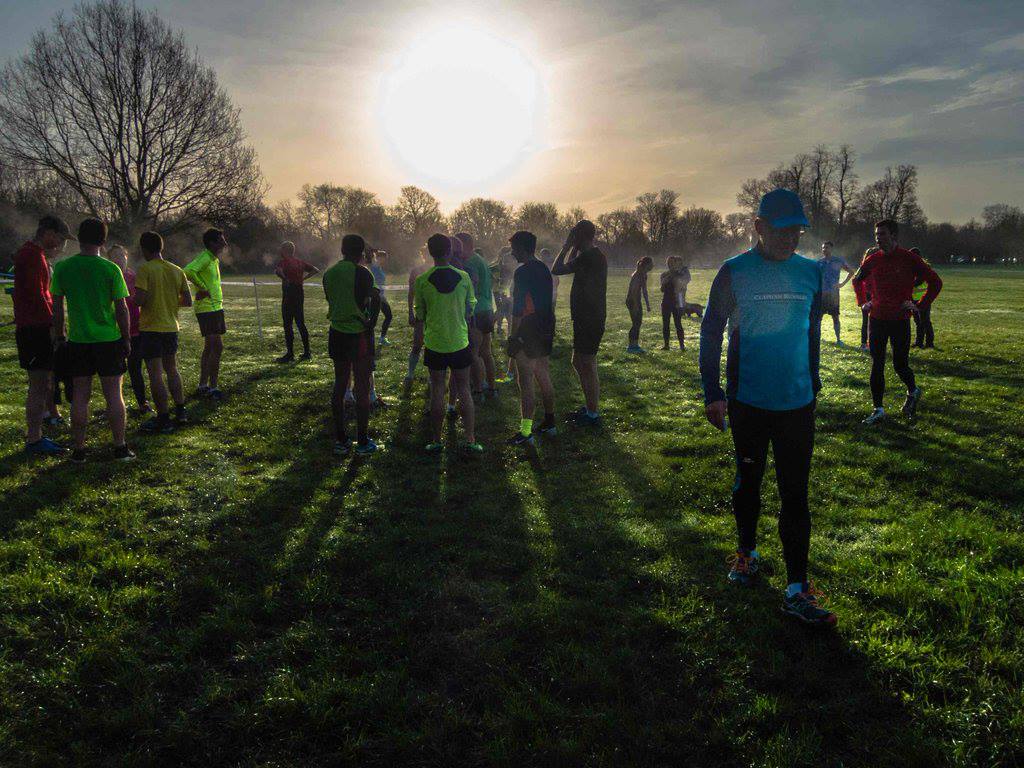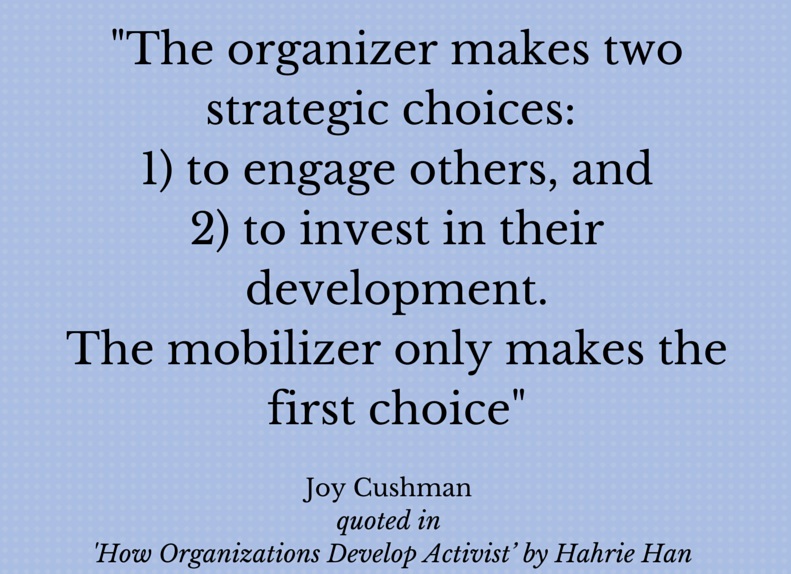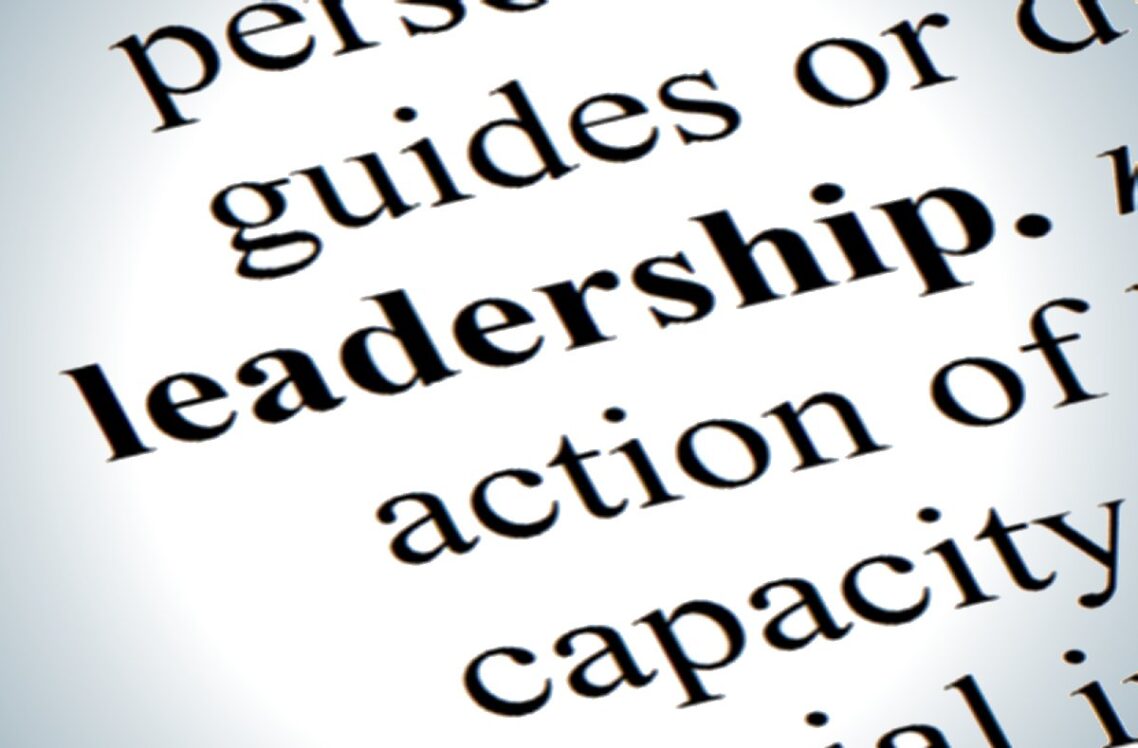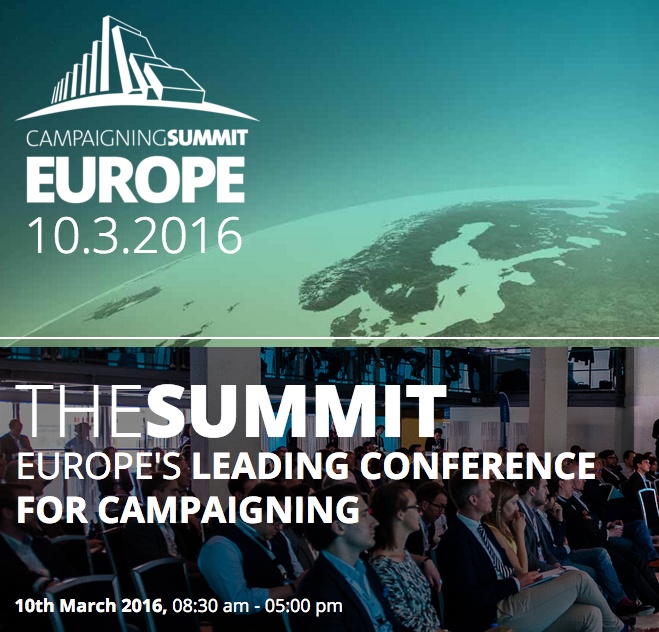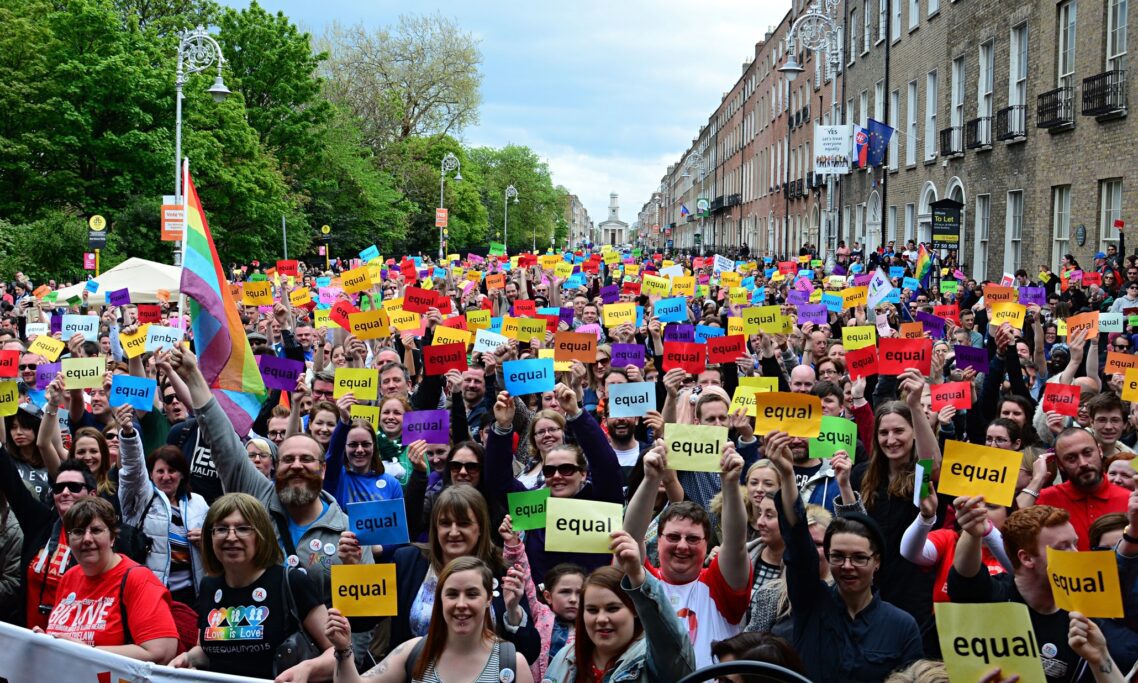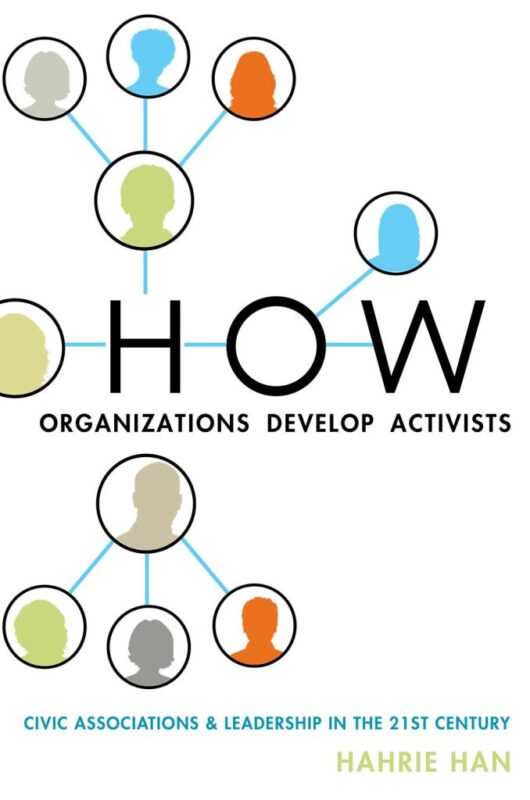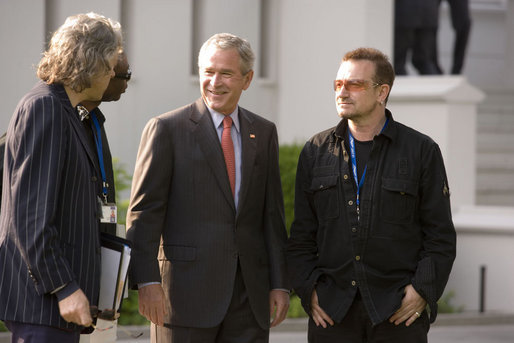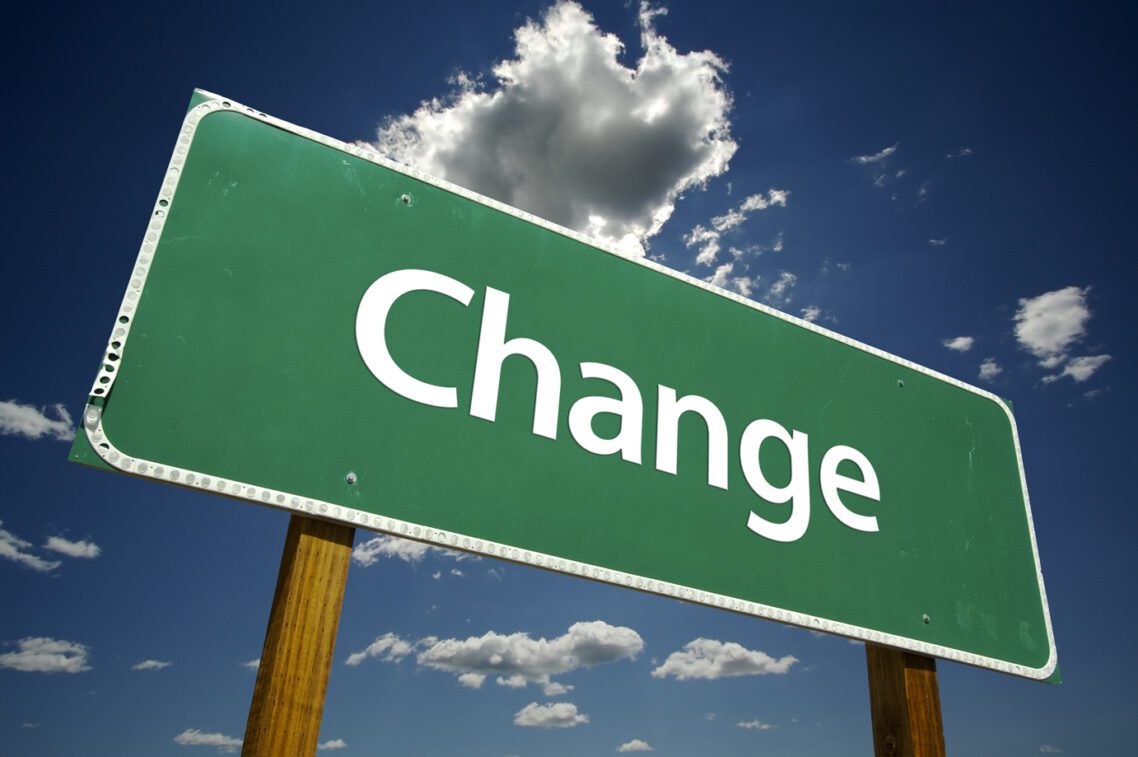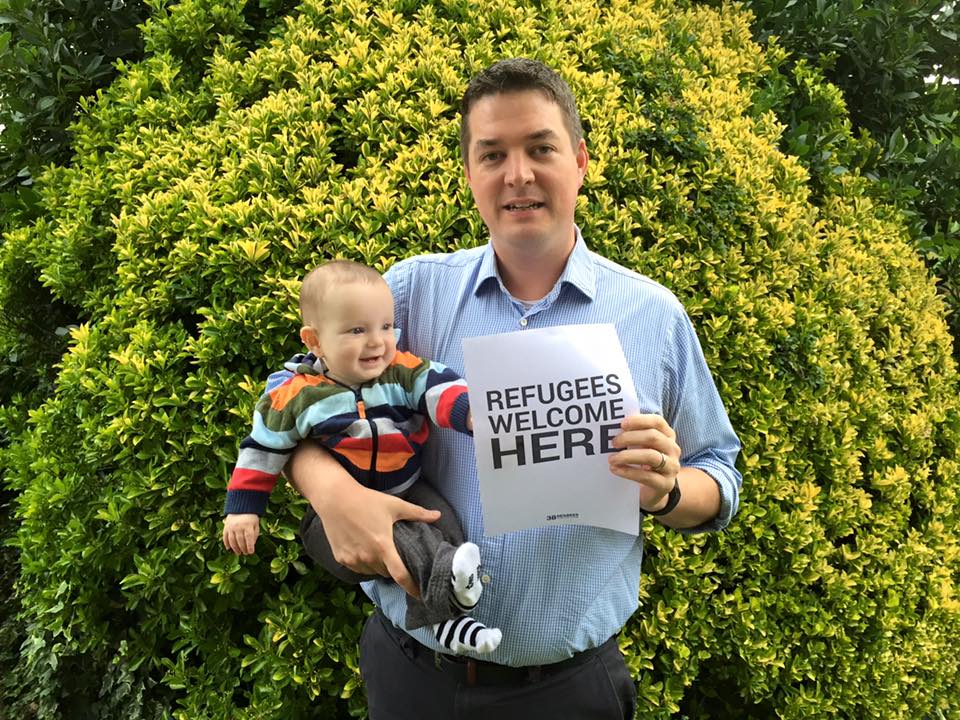Since the new year my Saturday morning routine has changed – it’s no longer reading the paper over a cup of coffee.
Instead you’ll find me standing outside in the cold at 8.55 with at least another 100 people ready to run 5km. I’ve officially become obsessed with parkrun. In fact I wouldn’t be exaggerating to say I’ve fallen for the concept.
parkrun for those who haven’t come across it is a free, weekly, 5km timed runs around a local park. They are open to everyone, free, and run by a team of volunteers.
Around the world there are over 700 parkrun’s – all of which have started in the last 10 years – with almost 1,000,000 having taken part in a parkrun in the UK alone. As a result the founders are getting lots of interest from government about how they’ve been so effective at increasing participation.
Now part of the reason I’ve fallen into parkrun is the result of campaigning. For over the last 18 months we’ve been campaigning to get our local council to allow us to run around Tooting Common, but that’s a story for another time.
But I think Park Run has already taught me a few lessons for campaigner about how to successfully engage people and build community.
1. Make the barriers to entry really low – getting involved in parkrun is easy, really easy. All the information you need is on the website and the only thing you need to do is register and print off your bar code which you use to get your time. All the information you need is on the website and there isn’t any pressure about having to to turn up in the right gear or in the latest trainers. The message is come and join us at 9am.
2. Encourage participation not performance – The motto of parkrun is that it’s just that a run not a race. Many people who might not see themselves as runners come along and get involved. The emphasis is not on how fast you run and the first and last runner get exactly the same experience. Although your encouraged to improve your personal best it’s always about participation – not expectation to become the next Mo Farah or Paula Radcliffe.
3. Provide incentives and quick feedback – Within an hour or so you get your run time emailed to you, it’s quick feedback on how you did. In the same vain, the weekly run report is a key volunteer task to help people feel that they’re part of a community. And built on the emphasis on participation not performance each run you do gets you one step closer to joining different ‘clubs’ which celebrate different milestones. It really helps to increase participation.
4. Build leadership – Each parkrun relies on a volunteer team to make it happen. From marshalling to report writing there are a whole number of roles that need to be filled. This isn’t about being elected onto a leadership team but about an ethos that encourages people to get involved. Somehow I’ve gone from being a ParkRun to making my debut as the Race Director in a few weeks’ time – I think my experience of running campaign events probably helps here – but the principle still stands, Park Run actively builds leadership – and encourages people to get involved in helping to lead there parkrun.
5. Encourage community – Parkrun might start out as standing in a park but it always finishes in a cafe. Community is very much encouraged and actively built. Even though I’ve only been involved for a few months I’ve started to see it in action. Last week, we had NAME join us to celebrate doing 250 run – but that wasn’t a solitary achievement, friends that NAME had met across the parkrun community joined her to run.
6. Make it easy to replicate – Parkrun hasn’t grown as the result of a central team of paid staff setting up them up one run at a time, instead the small parkrun core team make a whole host of resources available to local groups of volunteers looking to set up a run. They play an enabling role – recognising again the need to build leadership, and as a result new runs are starting all the time.
While many of the principles above aren’t new to those who’ve been experienced at building activists groups – watching how parkrun has grown so quickly, especially drawing in so many new people should provide new insight for building activist communities.
Finally, If you want to understand what all the fuss is about, watch this little film about why so many people #loveparkrun.
Category: learning
Organising to build power – reflections on Hahrie Han skillshare
Yesterday I had the opportunity to spend a day learning from US academic and trainer Hahrie Han on how we can organise activists. It was a cracking day alongside 50+ other campaigners, full of lots of thought provoking, challenging and inspiring content about how we can work to organise activists to deliver change.
It’s part of a series of events that Hahrie is doing while she’s here in London, this evening Hahrie is giving a lecture in conjunction with the University of Westminster. While the lecture is fully booked you can watch a free web stream of the lecture from 5.30pm today (31st March) here.
Walking away from the day I’m struck by a few lessons that I want to dig into more in my work.
1 – We need to get comfortable talking about transformation and power – Perhaps its our British reserve but because the word transformation seems to be associated with religious fever, while power is seen as a battle between good and evil, we don’t feel comfortable talking about them.
But as Hahrie suggested ‘movements build power not by selling people products they already want but instead by transforming what people think is possible’. We need to help people believe that transformation is possible and that starts by talking about it.
When it comes to power, we spent time considering the work of Steven Lukes and his Three Dimensions of Power. Lukes argues that power is exercised in three ways – visible, hidden and invisible.
Visible power is what we see happening in voting in elections or in Parliament – it’s perhaps the form of power that as campaigners we spend much of our time considering – how can we get MPs to vote for our issue in Parliament for example, but invisible power are the factors/beliefs/assumptions about how the world works that are often imbedded into our institutions.
Campaigners can spend lots of time talking about how we can overcome visible, but organising requires us to consider invisible power that prevents challenging the status quo. We need to spend more time talking about and wrestling with where power really is, and strategising on how we respond.
2 – Agency is about autonomy as well as competence – Agency is the ability to achieve purpose – and in most western countries individuals sense of agency is declining. We’ve often see increasing agency in those we work with as simply providing people with the skills they need – so they have competence to go out and make the change we’re looking for – perhaps because they’ve been trained to use a particular tool or approach.
Hahrie suggested that agency is not simply about make people feel they have the competence to use a tool it’s also providing them with the autonomy to use those tools – the space to act on it free from the control of an organisation.
3 – Good organisers are not always the first to put their hands up – Zack Exley one of Bernie Sanders lead organiser has spoken about ‘the tyranny of the annoying‘ when the worst people with the most time on their hands take over, and when it comes to picking organiser the same could be true.
Good organisers aren’t always those who are the first to volunteer, they can just be those with time to get involved, but instead individuals who have an ability to learn and reflect, are able to hold the juxtaposition between pain (the challenge of injustice) and redemption (hope that it can be overcome) and relational capacity.
4 – What brings you into belonging to a community – Growing up in a church community, I spent lots of my teenage years in debates about if becoming part of the church meant that you have to first believe then behave before you could belong. There is a growing conversation in church circles that actually the focus should be on belonging, and from that behaviour and belief will come. See below for more on this.
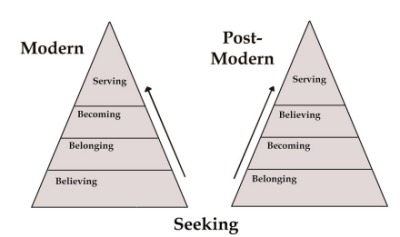
For many who come into activism the same is true. We often assume that people’s engagement in our issues comes first from a belief in our message and from that becomes the behaviours (like taking an action) and belonging (forming your support for an issue as part of your identity).
But evidence from pro-life activism in the US suggest it’s the other way around. Half of those who got involved in pro-life activism were indifferent to the issue when they first got involved, instead they did so because they were looking for community or invited by a friend. The belonging came well before the believing, are we creating activism spaces that encourage belonging?
5 – It’s not just about how profitable an organisation is – When it comes to metrics of success, we should take the same approach that financial analysts who don’t just judge the performance of a company in a given year on the profits they’ve made, but also the assets they have which inform their ability to make future profits for an investor.
Should the same be true of our approaches? Focusing on the wins achieved (the profit) but also the capacity going forward (the assets) which will inform the change we can deliver in the future.
There was lots of other insight wrapped up in the day, but I also walked away with some very practical reflections;
- We need to be finding our own community of academics and practitioners who are researching this – most of the literature that we covered was drawn from the US (and even then the body of work is fairly small). We need to find academics in the UK who want to dig into what’s working and not working here.
- It’s about mixing up and learning from different disciplines – Across the day we drew on insights from a range of approaches as wide as behaviour psychology to those teaching at business schools. Campaigners and organisers would do well to learn from across academic approaches.
For those who joined the skill share or the lecture, I’d be interested in learning what you’re thinking.
Campaign innovation and the US elections
I get hugely excited about the US elections – and now we’re 2 months into the primaries – it’s a good opportunity to look at some of the different innovations, tactics and approaches that the campaigns have been using.
So here is some Easter reading from the campaign trail – and don’t worry it doesn’t mention Trump once!
1 – Bernie Sanders is building a whole new approach to organising – Lots has been written about the Obama organising model, but reading about the Sanders campaign it looks like he’s building ‘Organising 3.0’, with a focus on local empowerment and leadership coupled with technological innovation. This from Paul Hilder who is inside the campaign is good as is the always excellent Sasha Issenberg.
2 – Everyone is using persuasion – I’ve long been fascinated by how social pressure techniques can get individuals to take action. It’s a growing area of academic research mainly in elections – for example helping someone make a plan for voting on election day can increase turnout by up to 4% – this is a good primer of some of the approaches used in the Iowa Primary.
3 – It’s getting harder to reach people on the phone – but text is where it’s at – Phone banking had long been a key element of reaching voters but its getting less and less effective – in one week in January, the Sanders campaign had to make 250,000 calls to have just 11,000 phone conversations, but all the campaigns are actively trying to build SMS lists (and the Sanders campaign is also using some cool tools to engage volunteers via text)
4 – Digital innovation – From Hilary Clinton on Snapchat, Ted Cruz’s campaign mining information from Facebook profiles, John Kasich looking at networks built from offline sources of information and the use of Facebook Live lots of campaigns are doing interesting digital innovation. Lots more here.
5 – You probably can’t win without getting the basics right – While it’s easy to get excited about the new tools and approaches, campaigns still need to be won by getting people out to vote, and that needs a well targeted ground game something that Ted Cruz’s campaign used to led him to victory in the Iowa primary. While on the Democratic side, Bernie Sanders team have build a app that allows anyone to start canvassing for him.
I’m sure in the next 6 month we’ll see lots more interesting innovation and learnings from the US campaign trail. Watch this space.
Leadership roles within an advocacy movement
I’m reposting some of my favourite and still relevant posts from the archives. This first post looks at the variety of roles needed in any advocacy movement. I’m reposting it after reading this over on OpenDemocracy.
American’s love the concept of leadership. Go into any bookshop and you’ll find shelves dedicated to the subject, attend a conference and you can guarantee that the word ‘leader’ will have been used a dozen times before the lunch break.
So perhaps it’s no surprise to find that it’s our colleagues in the US who have been thinking about leadership models and advocacy.
The Institute for Sustainable Communities – Advocacy and Leadership Centre has produced ‘Leadership Roles within an Advocacy Movement’, a short and readable paper in which they identify 11 different types of leadership needed within a movement arguing that ‘a movement must have a plurality of leaders, filling a cabinet of distinct, yet complementary, leadership roles. By utilizing a diverse cabinet of leaders, a movement develops a powerful dynamic that strengthens and emboldens, bringing the movement closer to optimum gains and successes’.
The list looks like this;
-
Visionaries who raise the view of the possible
-
Strategists who chart the vision and achieve what’s attainable
-
Statespersons who elevate the cause in the minds of both the public and decision-makers
-
Experts who wield knowledge to back up the movement’s positions
-
Outside Sparkplugs who goad and energize, fiercely holding those in power to account
-
Inside Advocates who understand how to turn power structures and established rules and procedures to advantage
-
Strategic Communicators who deploy the rhetoric to intensify and direct public passion toward the movement’s objectives
-
Movement Builders who generate optimism and good will, infecting others with dedication to the common good
-
Generalists who anchor a movement, grounded in years of experience
-
Historians who uphold a movement’s memory, collecting and conveying its stories
-
Cultural Activists who pair movements with powerful cultural forces
I don’t disagree with any of these but wonder if they’ve missed out a couple of key leadership approaches;
Pioneer – Someone who pushes the movement to make use of new tools and tactics. Most recently they would have been engaged with making the most of digital tools to further our campaigning, but throughout the history of campaigning we’ve had individual leaders who have been prepared to push into making use of new tools and tactics. This is different from the ‘visionary’ because they’re defined by the tactics they use.
Administrator – Too often forgotten but every campaign needs a solid and dependable administrator. This is not simply a service function, but a leadership function, someone who is their to ensure that the organisation of the campaign keeps pace with the growth of the energy behind a campaign issue. Too often campaigns fail because they don’t have the material resources or the structure to sustain them.
I was also thinking about the idea of adding in a ‘visualiser/designer‘. Someone who use creative tools to help communicate the essence of the campaign. Someone who harness the notion that ‘a picture is worth a thousand words’, but I’m not sure if this is more a branch off from the ‘strategic communicator’ role than a stand alone approach.
Postscript – The comments on the original post generated a few suggested other roles;
The Activist – the person who constantly pushes others to action, who says “Let’s stop talking and DO something!” This not the “cultural” activist (which I suspect is hard to distinguish from the Strategic Communicator). This is the person who boards the oil rig, who takes round the petitions, who pushes the boundaries of what normal people are willing to do. Some movements are dominated by these Activists, especially the “non-violent direct action” folks.
The Process Addict – every movement has these, especially when there is consensus decision making! This is the person who holds people to the values of the movement, and helps develop an internal culture that is ethically consistent. You may think “that’s not a leader!”, but actually a good many social movements reject hierarchical models of leadership altogether. You can’t ignore the long tradition here. The Process Addicts are concerned with means as well as ends, and hold people to values of respect and openness even when they are “inconvenient”. Too often “leadership” implies single individuals taking major roles and responsibilities. Don’t forget that the shepherd can be a leader too.
What do you think? What else has been missed out?
Mobilising for Impact – links from my talk at The Campaigning Summit
Today I’m excited to be speaking at the Campaigning Summit in Vienna – it’s a gathering of over 300 campaigning professionals from across Europe (check out the amazing talks from previous Summits on video).
I’m going to be speaking on ‘Lessons I’ve learnt about how to mobilise for impact’
I’m going to be drawing on some of the lessons I’ve learnt from working on global poverty issues for the last 10 years or so. I’ve only got 20 minutes to fit a lot in, so I’m posting the key points and useful links to further resources.
Hopefully they’re useful to both those at the Summit and those reading the blog.
1 – Ask do I need to mobilise? It’s a question that we don’t ask enough. I explore some more key questions we should be asking here.
2. Build a politically diverse coalition – this is a good resource which looks at some of the different models that have worked. I’ve also written on how to make campaigning in coalition work here.
3. Nurture your activists – find out more about the work of Hahrie Han here and here. My friend Natasha Adams has written more here, and I contributed to a series of articles based on the book here. The table I shared in my presentation is below, taken from this blog by Jim Coe (who is also the host of an awesome advocacy podcast).
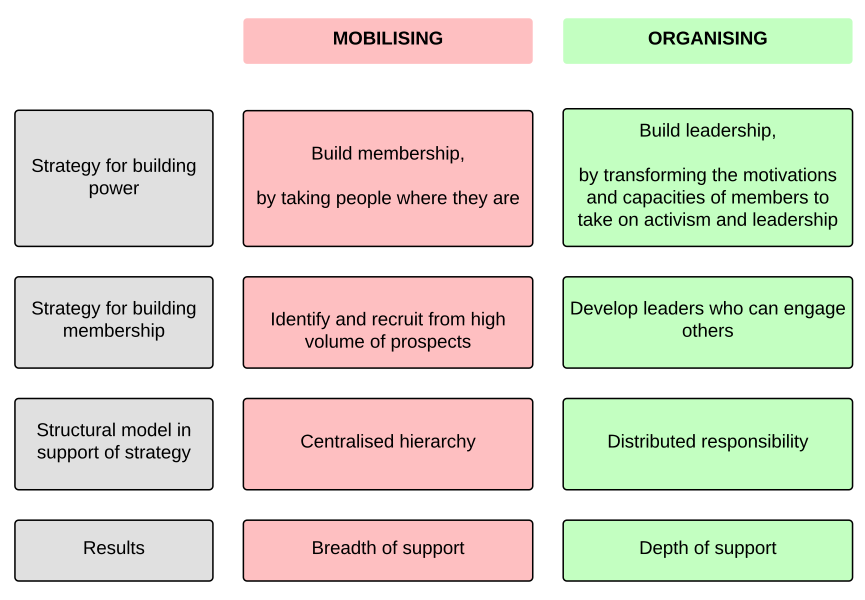
4. Focus on moments but beware of the cliff! – some tips for avoiding the cliff!
5. Learn from others – This is the brilliant Purpose Drive Campaign overview I mentioned (and more here). On learning from Bernie Sanders I enjoyed this and this.
6. Say Thank You and Celebrate – my learning from the Turn Up Save Lives campaign and some reflections on Make Poverty History.
And finally;
- Do follow me on Twitter
- Subscribe to get my latest post by email here.
- If I can speak at a event or conference you’re running, get in touch.
Lessons from #BondConf session 'Secrets of Winning Movements'
I had the pleasure and privilege today of hosting an amazing set of campaigners at a session on ‘Secrets of Winning Movements’ which was part of the Bond Conference.
Over 90 minutes, a wonderful line up of speakers shared top learnings from movements as diverse as the campaign to win equal marriage in Ireland, to Mumsnet and it’s wonderful member generated campaigns, to 350.org and a focus on divestment, to the inspiring stories from those at the heart of the Tunisian revolution to community organising in the UK to welcome more Syrian refugees.
Trying to chair and live tweet it was hard to take lots of notes, but briefly, and before I forget them all, here are some of my key learnings;
- Movements are messy – they require you to experiment with what’s working and not working. To iterate and innovate. To change tactics.
- Ensure there are strong relationships at the heart of your movement – take time to build trust with those involved.
- Leadership is about the relationships you have to get people to take action.
- Help prevent burnout – Don’t forget to provide space for those leading your campaigns to take the time they need to sustain there activism.
- Focus your message – Grainne Healey shared about the importance of finding a messages that worked for the ‘middle million’ in the Yes Equality referendum campaign. That meant taking what focus groups were saying seriously.
- A movement need a clear slogan – but ensure that resonates with those you need to engage not simply your ‘base’
- The messenger who delivers your message is as important – make sure they work with those you’re trying to reach.
- Humour, satire, parody and ridicule all have a role in campaigning – find creative ways of getting the message out.
- Use social media effectively – Aya Chebbi from Tunisia shared about how those leading the revolution would use it to get the news they wanted out first.
- Pick the target, freeze it, personalise it and polarise it – Jonathan Cox from Citizens UK shared about how they’d focused on Bristol Mayor George Ferguson to agree to welcome more refugees through a relentless focus on him.
- Give people a sense that they can make a difference – Payal Parekh from 350.org shared about how the divestment movement success has been built on the experience of local campaigners making a local dent on a global problem.
- Training is critical for equipping your movement and sharing the vision.
- Be movement generous – many of those you train and equip will go on to work on other issues. Celebrate that.
- Learn from others – Grainne shared about how the Yes Equality campaign had benefitted from the insight of US marriage equality campaigners.
- Build unusual and diverse coalitions – not just the usual suspects.
- But sometimes its as important to decide who not to include can be as important as who is involve. Rowan Davies from Mumsnet talked about who didn’t get involved in a coalition they built on libel reform
- Be clear about the role your organisation is playing. For many NGOs its about supporting the existing movement.
If you were in the session, please feel free to add your key lessons and learnings in the comments below.
Join me at 'Organising or Mobilising – How organisations can develop activists' on 31/3
One of the best books that I read last year was ‘How Organizations Develop Activist‘. It’s very relevant to the work of campaigners (if you can get over the use of z rather than s!), so I’m really excited to say the books author, US academic and activist Hahrie Han will be heading over to join us in London in late March.
Working with colleagues at Action Aid, Friends of the Earth and Christian Aid we’ve been able to arrange for Hahrie to give a lecture at the University of Westminster at 5.30pm on Thursday 31st March, and an already sold-out day long skill share.
The lecture is open to anyone that’s interested in – and I’d strongly recommend it to any campaigner, community organiser or political strategist. Click here to register.
The lessons will be as relevant if you’re trying to get a Councillor elected in a by-election as if you’re trying to get governments to sign up to an international agreement on child survival.
But if you need more convincing here are some reasons why you should plan to join us, and a bit of background if you’ve not had the opportunity to hear from me in person about my enthusiasm for this work.
1. It’s based on real evidence of what works – Hahrie has turned her research lens on how charities approach organise their organising. The work in the book is based on a comparative study of two US organisations, one working on health and on the other environment. While their are differences between the UK and the US there are huge amounts of shared insight to take from it.
Central to the book is the ideas that groups can be categorised into Lone Wolves, Activists and Organisers. Lone Wolves are those who chose to ‘to build power by leveraging information — through legal briefs, public comments, and other forms of research advocacy’ while ‘mobilisers and organizers, by contrast, choose to build power through people’. This isn’t just an theory but based on lots of research from groups across the US.
2. It’s about taking learning from community organising and the Obama campaign approach as well – lots of campaigners are rightly excited about the insight that community organising approaches that groups like Citizens UK use, or the Organizing for America approach used in the Obama. But sometimes the application to the campaigning work of charities isn’t as easy to see. Hahrie’s work has looked at both of these approaches (indeed she’s written a whole book on the approach that Obama took in organising his campaigns) and helped to think about what it means for charities.
3. It’s bring new insight to an time honoured approach – For many the focus for charities over the last few years has been focusing on build the number of supporters who can take e-actions. That’s not a wrong approach, but it’s easy to see how building a network of activist can be deprioritised within that.
For Hahrie central to what works is understanding that there is a difference between activism and organising means and both are needed to deliver change. This from Joy Cushman sums it up well “The organizer thus makes two [strategic] choices: 1) to engage others, and 2) to invest in their development. The mobilizer only makes the first choice. And the lone wolf makes neither”. At the skillshare we’ll be able to dive deeper into understanding what this means for our work – something one of my co-organisers Natasha has written a cracking post on this here.
4. It’s about walking away with practical ideas that will help you build a better movement – When you read the book you have to do so with a pen in hand to capture the practical insights that come from the study, from the finding that the most successful groups were those that combined political and social activities, to the role of shared stories that get passed down within groups ‘do you remember the time when’ and much more. This isn’t research to file away, but practical lessons in how to develop activists.
How to build unexpected alliances that win
“It is more powerful to recruit unexpected allies than to galvanise the usual suspects”
One of the 5 lessons that Justin Forsyth shared during his ‘Changing the Changemakers’ lecture at the RSA last week reflecting on his time leading Save the Children UK.
I’d strongly recommend watching the whole lecture (or reading this article which summarises his lessons) because it’s packed full of useful insight about how change happens from someone who has been at the forefront of achieving it both outside and inside government, but the lesson about unusual alliances is one that resonated with me the most.
In his lecture, Forsyth cited the example of how the Religious Right in the US joined forces with Bono to persuade President Bush to massively increase the contribution that the US government made to fund the global response to HIV/AIDS and also the work that Save the Children have done with GSK – a company he had personally campaigned against in a previous role – in reformulating an antiseptic found in mouthwash into a gel that prevents serious infection of the umbilical cord, a common cause of death for newborn babies in poor countries.
Both show the power of unexpected alliances. This is a lesson is something I’ve written about before. But thinking about building unexpected allies also challenged me to ask are campaigners today doing enough to build those unexpected alliances?
While you could point to the Lobbying Act campaign that brought together PETA and the Countryside Alliance to collectively voice the concerns they had about the space to campaigner, on the whole have we have become to timid in the unexpected alliances that we’re building.
Make Poverty History might have forged a unusual coalition of development organisations, faith groups, trade unions and many other which got noticed inside Downing Street, but do campaigners today too quickly default to the ‘comfortable’ alliances which while broad have ceased to be ‘unexpected’ by decision makes.
Perhaps it’s because unusual alliances are harder to form in a social media age, when the backlash from an organisations or individuals ‘base’ is much easier to amply and quantify. Forsyth’s advice on that was that charity leaders shouldn’t be scared by criticism of unusual alliances – but rather asked to be judge on the impact they have.
So how do we start to build those really unexpected alliances?
1 – Think outside of the box – Stonewall is a cracking example here, partnering with Paddy Power to raise awareness of homophobia in Football, knowing that working with the firm would help them reach new audiences that Stonewall wouldn’t have alone.
2 – Prepare to be judged on impact – Justin’s advice is right, albeit hard to hold onto when your the organisation or individual being criticised, but unexpected alliances are those that make the political calculations that they’ll have the influence that’s needed at the highest level.
3 – Become a bridge builder – As Lisa Witter writes in this excellent article ‘leaders seeking to make social change are like all people: They feel most comfortable associating with others who share their point of view, values, and priorities’ but instead challenges us to become bridge builders ‘people and organizations that draw their power from their connections across issues and sectors, and specialize in translating the language of a specific issue tribe for (and building relationships with) potential allies outside of it’.
Her tips for doing that well are;
- Have the right expertise to know enough about an issue but not too much knowledge.
- Ensure others trust you.
- Work towards a cause, not a brand – this mirrors the point that Forsyth made about the need to build powerful platforms not just organisations
- Be connected
- Be a skilled communicator – to attract people and make them feel heard.
Campaigners: 5 priorities for your diary in 2016
First day back in the office? By now you’ve probably got through your email, removed the tinsel from around your computer screen and avoided the cakes that will see the end of your new year resolution..
But before you the newness of the year disappears, here are 5 further suggestions of things you might want to be booking into your diary to help you be a better campaigner in 2016.
1. Attend some training – If you’re in the UK, then you’re fortunate to have some great training courses available to you – they’re great opportunities to get out of the office and spend some dedicated time thinking about what you do. Starting out in your campaigning career then I highly recommend Campaign Bootcamp (disclaimer I helped to set up Bootcamp), here is what people have to say about the training.
At Bond, we’ve just launched two new courses for 2016 both designed to help take your advocacy to the next level. Developing an Advocacy Strategy is a day long course designed to help you to do just that, while How Change Happens is for experienced campaigners looking to improve the strategic clarity and effectiveness of their work. Needless to say I recommend both (and I’d love your ideas on what other training would be useful for campaigners).
If you’re interested in how to develop activist within your organisations, I’m excited to say that in late March I’m helping to host a series of events with US academic and activist Hahrie Han who wrote the book on this. More to follow soon.
2. Plan to get out of your bubble – I’m feeling like a broken record on this one, but I’m convinced that it’s critical for effective campaigning – my contention is we spend too much time talking to those who agree with us and are deeply engaged in our issue/concern – the reality is that most people have a tiny window to engage in our issue so getting out of the bubble and finding out how your issue will play with the residents of Corby (or wherever) is helpful for focusing and sharpening your messaging, and perhaps provide fresh focus for the direction of your campaign (see more here).
It’s one of Roger Harding from Shelter’s key learning from his work on housing – there he got his team spending time on high streets asking for feedback on adverts they were looking to run. You don’t need to go far to do this, for example plan to take time to read the newspapers or watch the shows that your target audience are reading, or volunteer to join on of your activist groups as they run a street stall.
3. Book in a Think Break – Last year I suggested that building in time to reflect. I’ve been terrible at doing this in 2015, but I’m trying again inspired by the idea of scheduling a quarterly ‘Think Break’ which I picked up on Chris Bailey’s Life of Productivity blog. The idea is that once a quarter you take one day off to think deeply about your work. I reckon it’s worth a go.
This webinar with blogger and author Beth Kanter on A Happy Healthy Nonprofit: 10 Tips for Impact without Burnout on Thursday 14th Jan also looks good.
4. Start a campaign – I appreciate not everyone can do this – it’s not something you can schedule in to do in a lunch break. But running a local campaign in my community to get my local council to agree to welcome at least 10 refugee families was one of the most enjoyable campaigning experiences I’ve had in a long time. It reconnected me with the passion and energy I get from activism. Using platforms like 38 Degrees or change.org make it super easy to do.
5. Let me come and hangout your team – Over the last year I’ve spoken on topics as diverse as learning from the Turn Up Save Lives campaign, how to make the most of your campaign petition, how a trustee board can best support campaigning, the secrets of effective coalitions and much more besides. It’s something I really enjoy doing, so if you’re looking for someone to speak to your team, department or conference please get in touch. Hell, if you just want to meet up for coffee to chat about campaigning let me know.
Last year I shared some advice on resolutions you should follow to make you a better campaigner. They’re still as useful for the next 12 months as they have been from the last 12 months! It included taking time to read, if it’s helpful I’ve shared my feedly collection of activism blogs, where I get many of my ideas available, here.
My campaign lessons from 2015
From winning a historic commitment to enshrine 0.7% on overseas aid into law, to being part of a global movement that mobilised 31 million people, to seeing friends celebrate success at the climate negotiations in Paris. 2015 has been a busy but brilliant year for me and my team at Bond.
Personally it’s also been a year of change, I became a father for the first time (proud father picture above), stepped back from being involved in the Labour Party at a time membership in the party surged (if you’ve just joined read my advice here) and tried to blog at least once a fortnight!
As we head toward the Christmas and the end of 2015, I’ve been reflecting on the lessons that I’ve learnt from the work I’ve done over the last 12 months.
1 – Winning is great – Development campaigning can sometime feel like change is secured by the inclusion of a paragraph here or a commitment announced there – all important but . So being part of the winning Turn Up Save Lives campaign was an awesome feeling and a moment to celebrate. Fast forward 9 months and I had the opposite feeling when despite mobilising hundreds of local residents to welcome refugees to Wandsworth the council rejected the plan. The ecstasy of winning and the agony of losing are the best fuel for campaigning.
2 – We need to say thank you – to our supporters, to our activists and to politicians when they deliver what we’ve called on them to do. To those you work alongside in your movement.
3 – It’s vital to get outside the bubble – One of the most enjoyable things I’ve done this year is take 5 days to drive a VW Camper Van around the country talking to people in city centers about the Global Goals. It was a good reminder that our issues aren’t front and center of people’s minds. Its something that I’ve experienced on the doorstep as well – most of the public aren’t interested in our issues. We all need to get out and about talking to Joe Public on the High Streets and Cul-de-Sacs of the UK
4 – Be movement generous – When I started the year explaining to people that the action/2015 campaign would be based on a ‘flotilla’ approach many weren’t convinced. The idea was we would agree on broad objectives and coordinate loosely around tactics but allow organisations to keep their own brand and not create a strong coordination structure. But the approach has worked remarkably well. The formal evaluation will capture all of the secrets of its success, but for me one of the key elements has been the commitment to movement generosity among those involved. It’s not always easy, but one of my keys to successful coalitions.
5 – Persistence pays off – Turn Up Save Lives was a campaign that had its roots in mass lobbies of Parliament in the 1980. The decision by Obama to reject the Keystone XL pipeline was a victory for a 5+ year campaign. It’s easy to get caught in 12 month planning cycles for our campaigns, but both are reminders that change can often take a lot longer.
6 – Elections change everything – Sure, perhaps none of us saw the result we got but the outcome of the UK General Election has changed the political dynamics dramatically (my initial thoughts here). I’ve spent my whole campaigning career under a Labour or Coalition government, and there aren’t many people around who ran campaigns under the Major government in 1996. Adjusting to the new political landscape is critical, for example the one individual I wished I’d spent more time campaigning towards over the last 5 years – George Osborne. The Comprehensive Spending Review in November showed he’s the one making many of the key political decisions in the current government.
7 – Spending time learning from disruptors – some of the most successful campaigns this year haven’t had a single NGO involved in them. Remember the milk price protests across the summer, or seen how Uber have pushed to get TfL to change the regulations of taxis in London. Both successful examples of using campaigning tactics to deliver change – and that’s before you look at the wins that change.org has delivered.
8 – Time to think about new approaches – the calendar has been packed with ‘moments’ this year – from UN Summit, to Election, to Climate Negotiations but is it time to move away from ‘moment’ focused campaign that we’ve grown comfortable with. The same goes for our tactics. I’ve spent lots of time reflecting on if we need to move away from petitions and do more to invest in our grassroots networks of activists. More to think about in 2016.
9 – Take M&E seriously – M&E isn’t often described as motivating and exciting, but as this excellent report from my colleagues at Bond suggests we need to be putting them into the public domain where they could more easily be used to improve the international development programmes of the future. It’s time as campaigners to do the same, to take M&E seriously (here are some thoughts on how to do that) and start sharing our evaluations.
10 – Take a break – I’ve been terrible at taking my own advice from the start of year. Time to start thinking about 2016 resolutions!
Finally, on a personal note, it’s been a record breaking year on the blog. Thank you to everyone who has commented, tweeted posts, signed up for email updates or just take the time to say they enjoy the blog. They’re all hugely motivating to keep going. I’m looking forward to 2016 where I’ll aim to continue to bring you regular posts on what’s happening in the world of campaigning.
